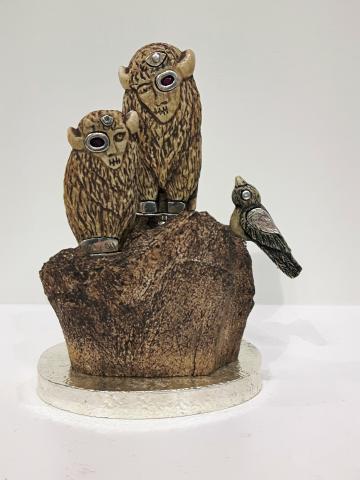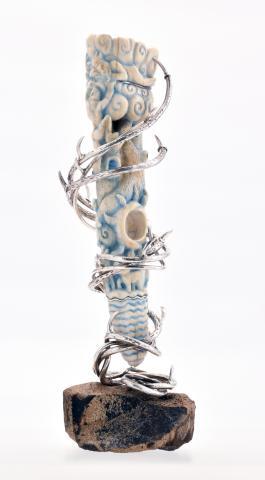BACHELOR OF FINE ARTS IN JEWELRY AND METALS, 2000
ALUMNI DISCOVERY INITIATIVE, INTERVIEW BY POLLY ORR, 2016
Polly ORR: When you graduated from ACAD was it a degree or diploma program?
Shona RAE: It was a degree program. I graduated in 2000 from the jewelry and metals program with a Bachelor of Fine Art with Distinciton.
ORR: How soon in your time at ACAD did you know this was the area you were most interested in?
RAE: I have been a professional artist who makes a living from the arts for thirty years. I was a ceramic artist, a sculptor who made one-of-a-kind objects, and then I started dreaming about hammering things. I took a class and decided I had to know more about metals. I went to the Kootenay Art School for three years in Nelson, and at the end of my three years there I applied to come to ACAD because I’d had so much training in the arts but never a degree. I was in my late thirties and early forties by the time I went through ACAD. I knew when I started that jewelry and metals was going to be my focus.
ORR: When you were in the jewelry program at ACAD did you find it to be interdisciplinary?
RAE: Oh yes! The reason I chose jewelry as a good area to study is because it is the crème de la crème of multimedia. Jewelry is all about learning how to put different media together. If you train in jewelry you can weld, and you can work in any material. There is nothing you don’t work in. That’s what I was drawn to.
ORR: What are some of the highlights of your time at ACAD?
RAE: I would say one of the most important classes I took at ACAD was my drawing class with Dave Casey. It was not about drawing; it was about critiquing and talking about work.
ORR: Do you find you still use those skills today, that ability to critique and the language you learned?
RAE: Oh absolutely. My husband and I are both artists and we both developed this language of design critique and use it everywhere we go. If we are talking about cars, it’s the design of the car. If we enter a room we are looking at the design of the furniture, the placement of it all, how the lamps fit with the rest of it. You take your art brain with you everywhere. It’s not something I separate or turn off.

Where Have They Gone?
Buffalo bone, sterling silver, rubies, oil paint, carved and constructed lockets and brooch on bone/box. 2017/2019, #9 in the “Natural Containments” series began in 2015.
ORR: How would you say your time at ACAD has impacted your career path now?
RAE: I think the most important thing that happened to me at ACAD is that I gained a confidence I never had before. I was shown a great deal of respect as an artist, even though I was a student. It helped me understand that there was no particular place I had to go in the world. I could belong anywhere. That was the most important thing I came away with. The art history classes, humanities classes and English classes I took were also significant for me. One English class I took changed my life.
ORR: How has your art practice evolved since you came to ACAD? You had art experience before, and art school was in the middle so I’m sure that evolution had already begun in many ways for you.
RAE: In that English class I took I realized I had to do this body of work which took me Twenty years to create. I had started it in 1998 before I went to ACAD, but I realized I had to continue it. I spent up until a few months ago putting all my efforts and resources into this project. Everything I did was to help support it. And I just finished it! Because I did that, I now have a vision practice.
I created seven or eight product lines in the meantime, ranging from fashion jewelry to sculpture that support me as an artist. They either came out of that twenty-year project or they fed that twenty-year project.
ORR: When you are doing a project like that, which is so long term, what keeps you inspired?
RAE: When I graduated from ACAD, in my last semester I committed to doing this project. It was creating twenty-two fairy tale ring sculptures. Once I realized I was going to do that I realized it was going to be a twenty-year project. I had already been practicing my art since I was fourteen years old. It was a commitment for this to be my opus body of work. I knew these rings were going to teach me how to master this new genre I had gotten myself into. By the time I finished making this project, I knew I would be a master.
ORR: Do you feel like a master now that this project is done?
RAE: Absolutely!
ORR: That’s got to feel good.
RAE: Yes, it feels good. Some people go to school to get their Masters’ degree. But I felt like I got my Masters’ in my own way on my own terms. I don’t feel the need to go back to get more schooling anymore.
ORR: It’s good to hear that. In a lot of professions there is a very set path, but that isn’t always the artist’s way. It’s liberating to know you can find your own path and it sounds like you did that.
RAE: Yeah. Everybody’s journey is different. I just felt like I had to make these pieces and because I was making them out of silver, gold, sapphire, diamonds, and rubies, I had expensive materials to work with and the project was incredibly time consuming. Some of these rings took me 300-400 hours each. But I allowed myself to do that. And I also received a couple grants to make them. That was always great.

Sleeping Beauty/XVIII The Moon
Walrus tusk, sterling silver, dinosaur bone, oil paint, carved and constructed ring sculpture, 10”H x 3”W x 3”, #18 in the “Re-Imagined Narratives” series 1998-2019.
ORR: How do you feel about the grant writing process?
RAE: Professional development courses have helped me a lot. I love grant writing. I write grants for all types of societies and for my personal practice. You don’t get very many, but if you don’t write them you don’t get any at all. I love writing grants, though. While I am writing them I also write a task list for a piece I want to make with lots of details. It makes me all excited for the project. I think it’s important to write all kinds of proposals. Every time you write it increases your skills.
ORR: How is it that you have found your artistic niche and audience within Calgary?
RAE: I have people come to my studio all the time. I run workshops from my studio. The Albert Crafts Council has been very good to me. They have exhibited me work and been very respectful. They even put one of my pieces on the front page of their magazine.
ORR: I believe that this interview is one way that ACAD is trying to reach out to their alumni, but is there anything else you can imagine as a way for them to show support to their alumni?
RAE: It would be nice if they had an alumni exhibition. Wouldn’t it be awesome if they had one year in the Illingworth Kerr where with each show they took a time period, the 80s, the 90s and showcased the respective alumni? Even if they just did one exhibition a year. Every once and a while they should reconnect with alumni who are professionals in their genre for a show.
ORR: What do you feel is the role of ACAD alumni is shaping our cultural and economic prosperity?
RAE: I think it’s the responsibility of someone who has a talent to keep making and working. In that way we contribute to culture. When you look back at history, and historical artefacts, all we have left is art. That’s what survives. Especially objects. Mosaics and ceramics and metal, these things last and give us a real idea of who we were. I think this is our responsibility as artist.
ORR: Has being in Calgary shaped your practice at all?
SR: Yes, I grew up and spent most of my life in the country. When I moved to Calgary, I found that the music scene here is what keeps me here. I got into rockabilly and that’s why I stay here. I can make my art anywhere I am. I will always be a maker. But the pool of musicians here is amazing. And my music for the first time in my life is completely informing my art. That’s really exciting for me that they are finally coming together.
ORR: How do you personally define success in your practice?
RAE: Critical success is very important to me, but I also have to pay my bills. I make a living as an artist and so the financial aspect is important. I can’t do nine to five jobs and that makes financial success key to what I do. But critical success is important too. Like the awards they give out at ACAD. They feed you. The acknowledgement helps you to keep going, especially when you are making work that is not necessarily commercial.

Sleeping Beauty/XVIII The Moon (detail)
Walrus tusk, sterling silver, dinosaur bone, oil paint, carved and constructed ring sculpture, 10”H x 3”W x 3”, #18 in the “Re-Imagined Narratives” series 1998-2019.
ORR: In that sense of working towards and eventually becoming a full-time artist, did you ever have to work against the stigma that making a living from it wasn’t possible?
RAE: I just never really had any choice. I am such an incessant maker. I had to figure out how to make a living out of it because it was all I ever felt like doing ever since I was little. It didn’t really surprise anyone when I became a professional artist because that’s all I ever did: make. When you keep that up long enough, people take you seriously.
ORR: It sounds like making was a huge part of your life, and regardless of whether you went to ACAD or not, you would have continued to learn and grow in your craft. Was there anything specific to ACAD that you feel you might not have learned elsewhere?
RAE: When I was at ACAD I felt like the sky was the limit. I could be as good as you could get anywhere in the world. And I don’t know if I ever would have understood that. Not to say that I am better than anyone else, but you realize that what’s happening around you could be happening anywhere in the world. When you’re inspired you’re inspired and that’s what matters. By leaving my small town I stopped thinking regionally and started thinking internationally.
ORR: If you had any advice for incoming first years at ACAD, what would it be?
RAE: You are not here to make your opus of work. You are here to learn and to experiment. Don’t put that kind pressure on yourself when making art. Don’t even worry about making art yet. Learn about art. I find that so often students get all freaked out because they want to make art. But you know what? Art is something that just happens. When you are open to learning and learning new experiences and trying new ways of looking at things, you are more likely to make art happenstance. Don’t start out making art. Absorb.